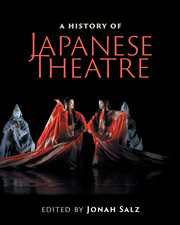Book contents
- Frontmatter
- Contents
- List of figures
- List of tables
- Contributors
- Contributors’ biographies
- Foreword
- Acknowledgments
- Note on Japanese terms
- List of abbreviations
- Timeline
- Editor's introduction
- I Traditional theatres
- Preface to Part I Japanese civilization arises
- II Modern theatres
- Preface to Part II
- III Arcs and patterns
- IV Theatre architecture
- Preface to Part IV Evolution of Japanese theatre architecture
- V Theatre criticism
- VI Intercultural influences
- 22 Seven stages of Shakespeare reception
- 23 Traditional training internationally
- 24 Intercultural theatre: fortuitous encounters
- Interlude Early influence from Europe
- Interlude Asian energy versus European rationality: interview with Ninagawa Yukio
- Epilogue: Frozen words and mythology
- Further reading
- Index
- References
22 - Seven stages of Shakespeare reception
from VI - Intercultural influences
Published online by Cambridge University Press: 05 July 2016
- Frontmatter
- Contents
- List of figures
- List of tables
- Contributors
- Contributors’ biographies
- Foreword
- Acknowledgments
- Note on Japanese terms
- List of abbreviations
- Timeline
- Editor's introduction
- I Traditional theatres
- Preface to Part I Japanese civilization arises
- II Modern theatres
- Preface to Part II
- III Arcs and patterns
- IV Theatre architecture
- Preface to Part IV Evolution of Japanese theatre architecture
- V Theatre criticism
- VI Intercultural influences
- 22 Seven stages of Shakespeare reception
- 23 Traditional training internationally
- 24 Intercultural theatre: fortuitous encounters
- Interlude Early influence from Europe
- Interlude Asian energy versus European rationality: interview with Ninagawa Yukio
- Epilogue: Frozen words and mythology
- Further reading
- Index
- References
Summary
Japan has seen a variety of Shakespearean productions, adaptations as well as literal and less literal translations, since the first kabuki adaptation of The Merchant of Venice in 1885. Styles and conventions adopted in producing Shakespeare's plays reflect not only the development of modern Japanese theatre but also the country's shifting relationships with the imagined West. Shakespeare has been the most influential Western dramatist since the Meiji Restoration in 1868, still one of the most widely performed of all playwrights in Japan. This section offers a brief overview of how Japanese Shakespeareans have continually sought to create original styles of interpretation.
Patrice Pavis remarks that in intercultural theatre, the target culture preserves “only a few elements of the source culture selected according to very precise norms … Every relationship with a foreign culture is determined by the purpose of the artists and cultural mediators who undertake its adaptation and its transmission.” The introduction of Shakespeare in Japan was similarly mediated. When The Merchant of Venice was produced in Japan in 1885, it was adapted into kabuki, then popular mainstream theatre, to reduce its foreignness. Sakuradoki zeni no yo no naka (Mercenary affairs under the cherry blossoms), contributed to “the construction of the modern Japanese nation … through partial and often mutually contradictory identification with and differentiation from the West, as represented by Shakespeare.” Shakespeare thus served as a stalking horse for transforming Japanese theatre, but also, during the early stages of Shakespeare's reception in Japan, Western realistic or mimetic drama became the standard regarded as suitable for the development of a modern Japanese drama. Shakespearean plays staged in translation by shingeki companies in the 1950s and 60s indicate that Western, particularly English, productions enjoyed the canonical position of models to be imitated. By contrast, reflecting Japan's ascendancy to the status of economic superpower in the 1980s, Ninagawa Yukio's (1935–) productions of Macbeth (1980) and The Tempest (1987) show how practitioners such as Ninagawa have finally been able to transcend their Western models.
The significant position that Shakespeare has occupied in Japan is also illustrated by English literary scholar Takemura Satoru, made during the period of militarism: “With the publication of Dr Tsubouchi's translation of Shakespeare's complete works, Japan is … now on equal terms with the Great Powers of the world.”
- Type
- Chapter
- Information
- A History of Japanese Theatre , pp. 484 - 496Publisher: Cambridge University PressPrint publication year: 2016
References
- 2
- Cited by



